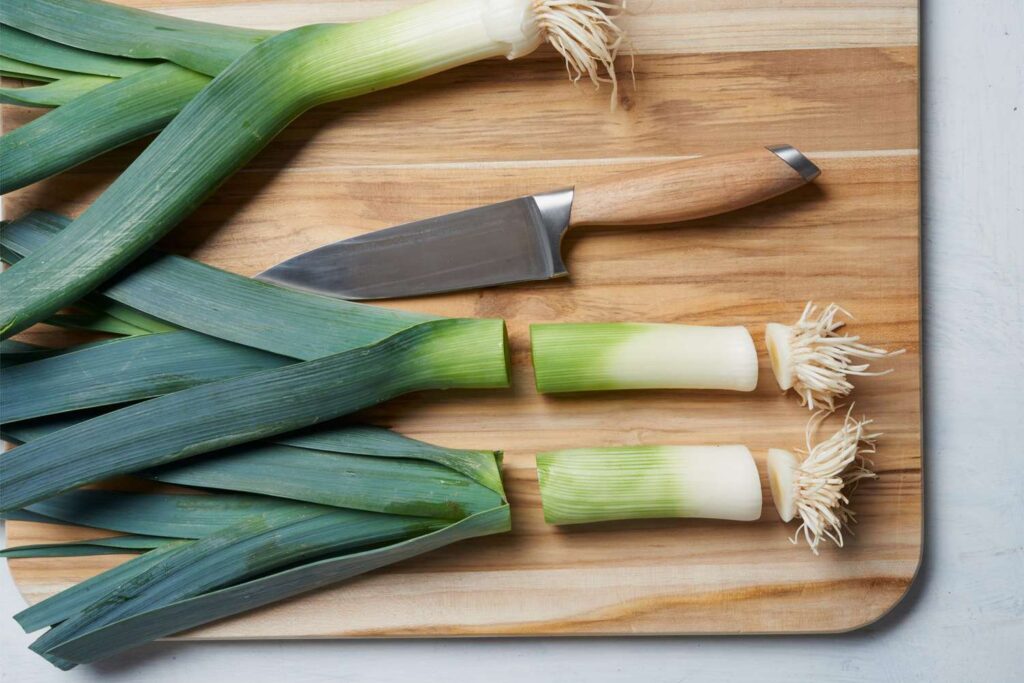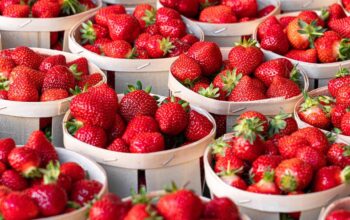Consider the leek.
In the onion family, it is a titan and majestic.
The darker green parts have plenty of flavors and can either be cooked longer to make them tender or used to make homemade soup stock. However, only the white and light green parts are typically eaten.
Table of Contents
What Are Leeks?
Leeks are a vegetable in the same family as the onion, garlic, shallot, scallion, and chive.
Although they look like a larger form of green onion, the edible part of the plant is actually the white and light green part – sometimes referred to as the stalk or stem.
The dark green part is also edible, but is quite bitter and is often discarded.
They have a mild, onion-flavor and can be eaten raw or cooked. They have a crisp bite and a stronger flavor when they’re raw.
Cooking leeks helps to mellow out the strong flavor and can be accomplished by roasting, sautéing, or even boiling.
History Of Leeks
The family of onions includes leeks. Leeks were a favorite food of the ancient Romans and Greeks. Roman Emperor Nero earned the nickname Porrophagus, or “leek eater,” after he took to eating them in large quantities in order to improve his singing voice. Leeks were highly regarded by the Greeks and Romans, but garlic and onions were only appropriate for the poor.
The ancient Roman cookbook Apicius contains four separate recipes for leeks, but only uses garlic and onions sparingly as seasonings. Today, leeks are not nearly as common as onion and garlic, which are the basic ingredients in most savory dishes. The times are a-changing!
Leeks were reportedly introduced to Britain and eventually Wales by the Romans, according to some historians. An old tale claims that the Welsh, who made leeks their “national emblem,” tucked raw leeks into their hats during the 7th-century Battle of Heathfield to make it simple for the soldiers to tell their friends from their foes. If the Welsh defeated the Saxons, was it because of their own strength or because they were better able to distinguish between allies and enemies thanks to the potent smell of raw leeks? We may never know.

What Should We Need?
Ingredients
- Whole leeks
- Sharp kitchen knife
- A large bowl of cold water
- Colander
How To Select Leek?
There are a few things you will want to look for in order to select the best leeks at the grocery store:
Selecting:
- Fewer green stalks and more white stalks. In contrast to green onions, you only eat the white portion. Look for leeks with a longer, white, edible stem.
- hardly any to no yellowing. The presence of yellow spots indicates that the leek is getting older and less fresh.
- Crisp and firm. Choose ones that are roughly an onion’s firmness. Beware of plants with wilting or soft leaves.
- Organic. Leeks are most directly exposed to toxic chemicals because they are grown in the dirt. Choose organic over conventional products when possible.
How To Clean Leek?
Cleaning:
- Fill a large bowl with water and add sliced leeks
- When all the dirt has separated from the leeks, toss them around in the water.
- Carefully pour the water out or use a colander.
- Pat dry before using.
How To Cut Leek?
Once you know the basics, cutting leeks is an easy and quick process.
A really sharp knife and one of your favorite cutting boards are all you need.
It shouldn’t take you more than a few minutes to slice for recipes:
Cutting:
- Cut off the root end of the leek
- Find where the stem and leaves (dark and light green) meet. Make a cut, then take out the leafy parts that are dark green.
- Slice the leek into thin slices after cutting it in half lengthwise for half-moon slices.
- For round slices: Starting at one end chop leeks into round slices
How To Store Leek?
Leeks last the longest when stored in a cool, dry place such as the crisper drawer in your refrigerator.
If they came in a bag, remove the bag to prevent excess moisture from building up.
Depending on the level of freshness upon purchase, leeks can potentially last for up to 2 weeks in the refrigerator.


